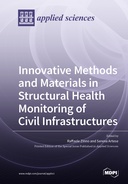Explore

Innovative Methods and Materials in Structural Health Monitoring of Civil Infrastructures
0 Ungluers have
Faved this Work
Login to Fave
In the past, when elements in sructures were composed of perishable materials, such as wood, the maintenance of houses, bridges, etc., was considered of vital importance for their safe use and to preserve their efficiency. With the advent of materials such as reinforced concrete and steel, given their relatively long useful life, periodic and constant maintenance has often been considered a secondary concern. When it was realized that even for structures fabricated with these materials that the useful life has an end and that it was being approached, planning maintenance became an important and non-negligible aspect. Thus, the concept of structural health monitoring (SHM) was introduced, designed, and implemented as a multidisciplinary method. Computational mechanics, static and dynamic analysis of structures, electronics, sensors, and, recently, the Internet of Things (IoT) and artificial intelligence (AI) are required, but it is also important to consider new materials, especially those with intrinsic self-diagnosis characteristics, and to use measurement and survey methods typical of modern geomatics, such as satellite surveys and highly sophisticated laser tools.
This book is included in DOAB.
Why read this book? Have your say.
You must be logged in to comment.
Rights Information
Are you the author or publisher of this work? If so, you can claim it as yours by registering as an Unglue.it rights holder.Downloads
This work has been downloaded 89 times via unglue.it ebook links.
- 89 - pdf (CC BY) at Unglue.it.
Keywords
- bearing
- box-girder bridges
- close-range photogrammetry
- condition assessment
- Crowdsourcing
- cyber-physical systems
- damage detection
- damage localization
- deformation
- displacement
- displacement analysis
- dynamic measurements
- edge detection
- environmental monitoring
- expansion device
- FEM
- Finite element method
- finite element model updating
- Fourier series expansion
- ground penetrating radar
- ground-based real aperture radar (GB-RAR)
- HBIM
- high-speed railway
- humidity-temperature sensors
- hybrid approach
- identification error
- jointless bridge
- Laser scanner
- line scanner
- load transverse distribution
- long-range mapping
- medicine
- MMS
- modal identification
- mode shapes
- Monitoring
- moving load identification
- multi-attribute utility theory
- multi-phase models
- n/a
- natural frequencies
- Neural Network
- overall deformation monitoring
- perspective transformation
- point cloud
- railway embankment
- Rhinoceros
- root-mean-square error (RMSE)
- scan-to-BIM
- spectral analysis
- strain influence line
- strain integral coefficient
- stress-laminated timber decks
- Structural engineering
- Structural health monitoring
- structural health monitoring (SHM)
- structural reliability estimation
- structure monitoring
- sub-millimetric EDM geodetic techniques
- subspace system identification (SSI)
- System identification
- temperature effects
- terrestrial laser scanner (TLS)
- tie rod
- timber bridges
- time-lag effect
- vibration frequency
- vibration-based damage detection
- wood moisture content
Links
DOI: 10.3390/books978-3-0365-0755-2Editions

